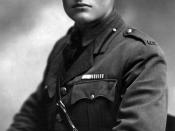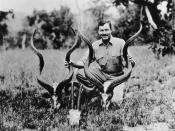"A Clean, Well-Lighted Place"ÃÂ by Ernest Hemingway "A Days Wait"ÃÂ by Ernest Hemingway "The Short Happy Life of Francis Macomber"ÃÂ by Ernest Hemingway "Indian Camp"ÃÂ by Ernest Hemingway "Soldier's Home"ÃÂ by Ernest Hemingway Ernest Hemingway has presented us with some of the best literature of the 20th century. He has been recognized in recent times as one of the greatest writers of all time, and the effect his work has left upon us is compared with that of Shakespeare's. His great success could be due, in part, to the fact that characters in his literature lead lives which mirror his own in many ways. Literary critics have dubbed these parallels "code heroes,"ÃÂ and have presented guidelines as to what lifestyles they lead in Hemingway's stories. I wish to show similarities in the presence of these certain, uniform traits that are common among Hemingway's code hero in the stories, "A Clean Well-Lighted Place"ÃÂ and "A Day's Wait,"ÃÂ both by Ernest Hemingway.
The specific elements that make up a code hero are as follows: (1) "Eat, drink, and be merry, because tomorrow you may die."ÃÂ (2) "When you're dead, you're dead."ÃÂ (3) "Avoid death at all cost, but don't be afraid to die."ÃÂ (4) "Always be disciplined, never show emotion."ÃÂ (5) "Grace under pressure."ÃÂ (6) Nada concept - a code hero is not comfortable at night. They become most active during darkness, because they fear it and try to avoid it at all times.
In the short story, "A Day's Wait,"ÃÂ the presence of code hero traits is evident in the thoughts, words, and actions of Schatz, the main character in the story. Schatz is a small child who believes that he is going to die, yet he does not fear it. Instead, the boy lies in bed...


